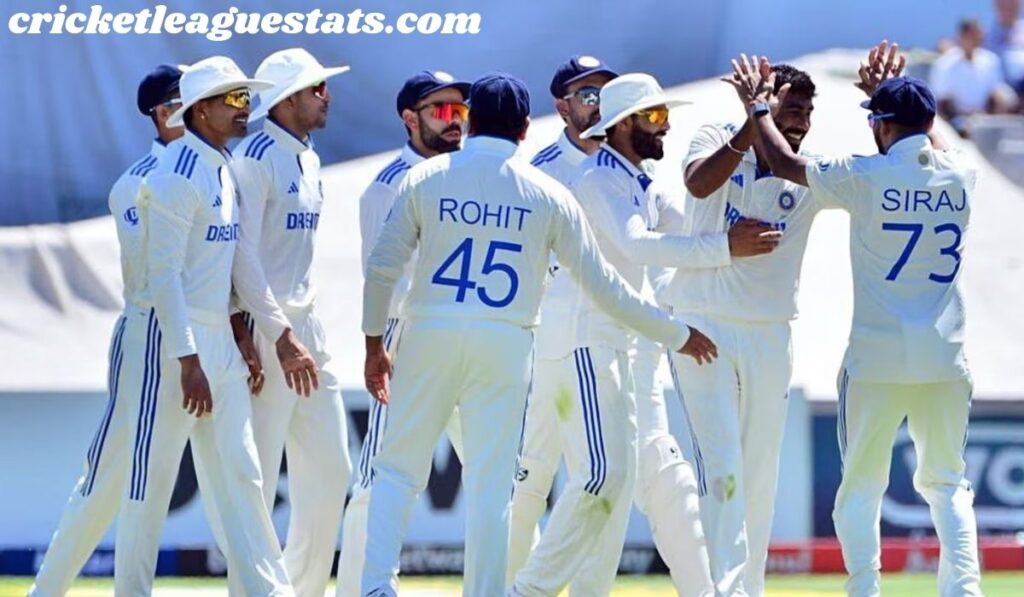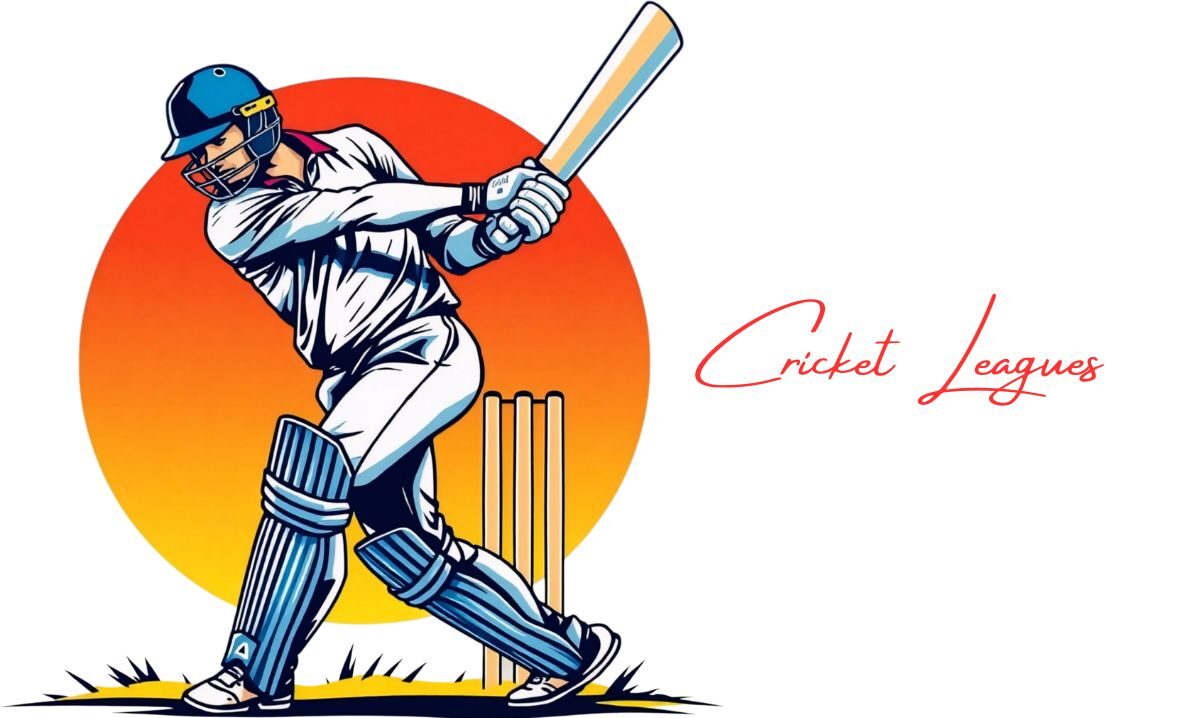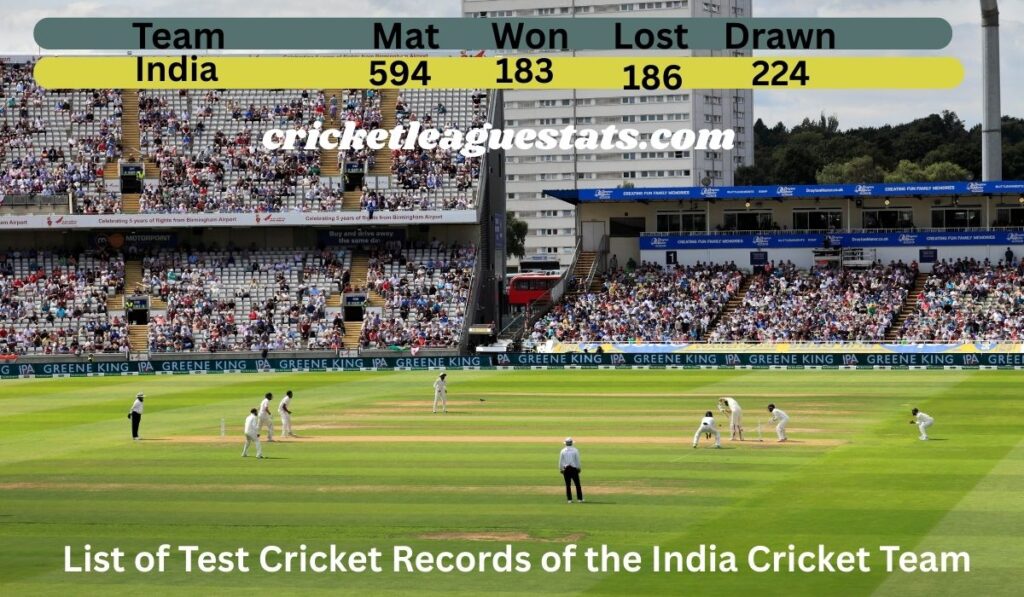The journey of the India National Cricket Team in Test cricket, from spirited underdogs to a global heavyweight, has an interesting history of transformation. It would be most practical to share the way the India National Cricket Team’s historic journey of transformation and records can be documented, as either a team, or price then as players of great distinction; as records are only ever just statistics, but in reality, they exist to highlight moments of brilliant individualism, shared resilience, and high drive towards excellence as Indian cricket has held through generations. These test cricket records are rivalled only by the memorable partnerships that broke records or exceeded bowling records that, collectively, put India at the top of the sport’s longest format.
Indian Team Test Cricket Records: Team Performance
Matches Played and Results
Since gaining Test status in 1932, the India National Cricket Team has played 594 Test matches during its illustrious history. The early years of the team were primarily characterized by the number of draws and, overall, a poor win-loss record. Nonetheless, over the decades, the team has improved considerably during its Test cricket journey, especially in the 21st century. Up to August 2025, India has won 183 matches, lost 186, and drawn 224 matches, with just 1 match ending in a tie, meaning that the win percentage of the team has been just over 30%. This experience has gone from a struggling team finding victories to becoming a well-respected team that can now win under all conditions, at home and away. It really shows how far Indian cricket has developed from that time, as well as the depth of player talent, the strength of the cricketing structure, and the fact that Indian cricket has consistently occupied the top tier of the ICC Test rankings, of late.
Notable Series Wins
The India National Cricket Team’s development into a successful Test team has taken place through a succession of valuable overseas wins that weren’t thought to be realistic goals. The watershed moment occurred in 1971 when Ajit Wadekar’s team won their first series in the West Indies and England. This pioneering spirit was taken forward by the team led by Sourav Ganguly, with a historic series win in Pakistan in 2004. The highest point of their overseas journeys came under Virat Kohli with consecutive series wins in Australia in 2018-19 and 2020-21. In particular, the latter, achieved with a second-string squad, established India’s capability to win in any condition and against any opponent.
Indian Team Test Cricket Records: Batting
Highest Individual Scores
India has seen several extraordinary individual scores in the history of test cricket, many of which earmark eras or win matches. The most adorned of these records, events, and accomplishments is Virender Sehwag, the only Indian to have made a triple century on two occasions, with his highest score of 319 made in Chennai (2008) v/s South Africa, known for its audacity and mirth. He also scored an evocative 309 v/s Pakistan in Multan (2004) – the first triple-century by an Indian player. Karun Nair made 303 not out against England in Chennai (2016) to become the second Indian with a score in excess of 300. He was certainly not as inspirational in his innings, as India were chasing 619 runs in what seemed a possible miracle chase at the time, and a (test) match with little regard for time. Lest we forget some scores, like V.V.S. Laxman’s 281 (and more importantly, his batting,) which inspired India to victory against Australia, and the same, with Rahul Dravid’s 270 in that you begin to appreciate how well this set of batsmen could play a match and endure the event leading up to it, which is the nature of test cricket.
Read More: Australian Men’s Cricket Team vs India National Cricket Team Timeline
Most Career Runs
The list of India’s most prolific Test batsmen is a record of reliability and utter brilliance. Sachin Tendulkar sits at the top of that list. His 15,921 runs not only make him India’s highest run-scorer, but the highest run-scorer in the history of Test cricket. Rahul Dravid immediately follows. Dravid (aka “The Wall”) is known for his unfaltering defense and incredible resilience; he garnered 13,288 runs as a player. One other legend is Sunil Gavaskar, who was the first Indian batsman to score over 10,000 Test runs. In his day, that was a massive feat and has influenced every Indian batsman since. Those three batsmen, plus V.V.S. Laxman and Virat Kohli, are a few batsmen who have helped carry Indian cricket and their batting legacy for decades.
Centuries and Milestones
The batting records for the India National Cricket Team feature a number of great milestones and centuries. Sachin Tendulkar has the record for the most Test centuries by an Indian with 51 centuries: an admirable number of centuries because his longevity and consistency are unparalleled. Behind Tendulkar is Rahul Dravid, with 36 Test centuries, a nice reflection of his solid and reliable career. The first Indian to achieve 30 Test centuries was Sunil Gavaskar, who set a precedent for future generations to chase. Besides these milestones, India’s batting records showcased some of the fastest centuries in Test cricket history, including Mohammad Azharuddin’s 100 in 74 balls and Virender Sehwag’s 100 in 78 balls, which were indicative of an aggressive, explosive batting style. These centuries provided contributions in team wins, and some great memories as well in previous years of Indian cricket history.
Partnerships
Partnerships have formed the basis for some of India’s most celebrated victories and defiance in Test cricket. The highest partnership in history belongs to Vinoo Mankad and Pankaj Roy; the only time an Indian side has had a 400-run opening partnership was against New Zealand in 1956. However, it would unquestionably be the V.V.S. Laxman and Rahul Dravid partnership of a 376-run fifth-wicket stand against Australia in 2001, which went from defeat to victory in imperishable glory. In terms of extraordinarily high runs, one could point to the 410-run opening partnership between Virender Sehwag and Rahul Dravid against Pakistan in 2006. From an aggregate standpoint, the top two combination batsmen in Indian Test history are Rahul Dravid and Sachin Tendulkar, having the most partnership runs for India as a result of their incredible trust and enormous longevity.
Indian Team Test Cricket Records: Bowling

Most Wickets
The bowling records of the India National Cricket Team consist primarily of spin greats who have successfully leveraged their home advantage and blown up on the world stage. The premier wicket-taker in India’s Test history, Anil Kumble, retired as India’s leading Test wicket-taker with 619 wickets from 132 Test matches and became the first Indian bowler to take 10 wickets in a single innings in Test history against Pakistan in 1999. He is followed by Ravichandran Ashwin, who, as of 2025, has taken 537 Test wickets and is the second leading wicket-taker for India. Ashwin also created history in terms of individual records as he is the fastest Indian to achieve a whole of milestones and has matched Pakistan’s great Muttiah Muralitharan throughout history as the most Player-of-the-Series awards. The great all-rounder Kapil Dev, who took 434 wickets, remains India’s most successful fast bowler. A true revolutionary pace bowler from India who set the bar high for pacers that follow.
Read More: New Zealand National Cricket Team vs India National Cricket Team Timeline
Best Bowling Figures
The records of the bowling performances of the India National Cricket Team contain some of the most stunning individual performances in the history of Test cricket. The most remarkable record is held by Anil Kumble, who managed the near-impossible task of taking all ten wickets in a single innings against Pakistan in 1999, as he garnered 10 for 74. This remarkable performance made Kumble only the second bowler in Test cricket history to achieve this record after Jim Laker of England. India’s best fast bowler, Kapil Dev, has the best figures for a fast bowler with his fiery 9 for 83 against the West Indies in 1983. How great Dev’s achievement was. These performances and others, along with the achievements of legends like Harbhajan Singh, established India’s bowling legacy, and they showed how India has been able to methodically destroy opposition.
Hat-Tricks and Five-Wicket Hauls
The bowling records of the India National Cricket Team also include amazing records with all-time highs like hat-tricks and the highest totals of five-wicket hauls. Only three bowlers from India have taken a hat-trick in Test cricket: Harbhajan Singh was the first to take a hat-trick in Test cricket against Australia in 2001; Irfan Pathan had the extraordinary honour of taking a hat-trick in the very first over of a Test match against Pakistan in 2006; and Jasprit Bumrah took a hat-trick against the West Indies in 2019. As to the best five-wicket (fivers) hauls, Anil Kumble and Ravichandran Ashwin lead the way. Up until recently, Ashwin has now taken the most fivers by an Indian with 37 and has recently surpassed Kumble’s 35. The fact that such a record is ever pervasive sheds light on the long-term prevalence of spin in India, their historical exploitation of this preeminence, and their current capabilities to continually shred opponent batting line-ups.
Indian Team Test Cricket Records: Captaincy
The India National Cricket Team and its captains have created a lasting narrative that has transformed it into a powerful Test side. This leads us to Virat Kohli, who, with 40 wins from a total of 68 matches (and not including the 2nd test match against Australia, more recently), certainly has a distinguished record. Kohli’s great achievement was culminating in an astonishing amount of success in overseas matches (not least remember that they were the first to win a Test series in Australia!) and is unparalleled. Dhoni then followed him, not to mention many matches as a captain, but also propelling India to have a very strong record at home when other Test countries were challenging India. Sourav Ganguly set a high standard, encouraged an aggressive mentality (and lifestyle) in a group of players that had probably lost their fair share of overseas matches. Ganguly led with respect and pushed India to win huge test matches and overseas series. These men, along with two of India’s greatest cricketers, Ajit Wakedkar and Sunil Gavaskar, clearly produced a legacy of leadership and consistency that elevated Indian cricket and helped it towards a higher place on the ladder.
Indian Team Test Cricket Records: Wicketkeeping and Fielding
Fielding and wicketkeeping form an integral part of India’s Test victories, and several Indian players (past and present) have achieved historic milestones in these skills. In terms of wicketkeepers, specifically wicketkeeping from behind the stumps, Mahendra Singh Dhoni is unsurpassed in terms of dismissals by an Indian keeper, with 294 dismissals (256 catches and 38 stumpings). In a Test against Australia in 2018, Rishabh Pant would create a modern-day record of 11 catches in a Test, while equaling the record for the most catches in a Test. In slips and outfielding, Rahul Dravid stands head and shoulders above everyone else with 210 catches as a non-wicketkeeper in Test cricket. These records probably do indicate that India has come a long way and developed some of the best fielders in the game.
Read More: Afghanistan National Cricket Team vs Australian Men’s Cricket Team Timeline
Conclusion
India’s National cricket team’s test cricket record list is more than just a statistics list. It is a great story of how the team progressed over time. Runs scored by batting demi-gods, quality spin bowling, and, interestingly, a medal collection once a team was able to improve India’s game. The changes in fielding and captaincy also illustrate the change from a team that struggled in most foreign environments to a nationally recognized competitive side that had the capacity and belief to win anywhere. This all firmly establishes India’s place at the top of the long format of the game while showcasing the deep-seated ethos of the game that exists and is entrenched in Indian cricket.



